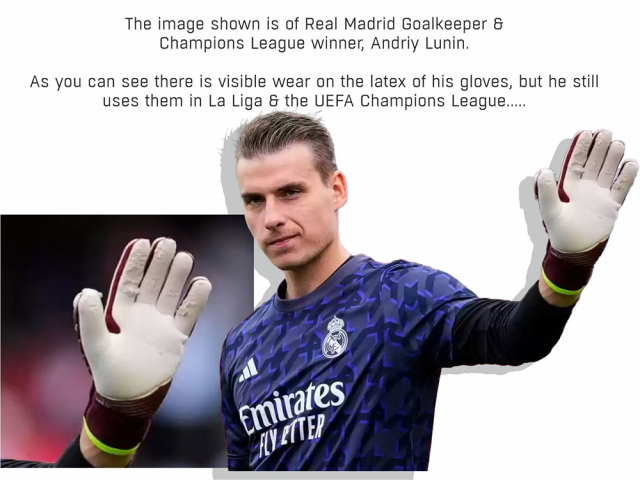- Goalkeeper Gloves
- Clothing
- Accessories
- Baselayer
- Juniors
- Sale
- Glove iD
- Shop By Brand
- Glove Care Guide
- About Us
- Help
- Product Information
- Shopping
-

Choose your region
By selecting a currency you will see the equivalent prices in your preferred currency at the side of the sterling prices. You will be charged in sterling when you place an order..
Select Currency

ALL GOALKEEPERS, ESPECIALLY MUM'S & DADS'S OF YOUNG GOALKEEPERS:
Although it is very hard to hear, the harsh reality is that latex will wear fairly quickly. Latex is a very soft product; it is this softness that provides the grip that all goalkeepers need and want!
The first thing to understand is that latex is a natural product and therefore cannot have a manufacturing fault.
The abrasion and wear in the main will happen when the gloves come into contact with the ground.
Latex may begin to show signs of wear from the first use. This is unfortunately normal; it can happen in your first game just as much as it can in your tenth. It is also possible to own two of the exact same gloves and see one pair last one month while the other lasts four months; this is the nature of latex.
If the latex starts to show signs of wear, don't worry! Wear is normal; that's just what latex does.
There is a huge misconception that when the latex starts to wear: they are "faulty," "not fit for purpose," and "no longer usable."
The truth? This is not the case!
Latex palms are usually manufactured with a 3-4mm thickness, so they will offer grip and continue to perform until worn through and there is virtually no latex left.
LATEX WEAR FACTORS:
- AGE OF THE GOALKEEPER
- GOALKEEPERS TECHNIQUE
- THE PLAYING SURFACE
- HOW THEY WERE PREPARED
- CARE INSTRUCTIONS FOLLOWED
- VOLUME OF USE
- LUCK!


Goalkeeper gloves are predominantly designed for use on natural surfaces like grass unless specified (e.g., a specialist 3G/astro-turf latex, which sacrifices grip for durability).
If you are using goalkeeper gloves on an artificial surface, you will be placing a higher level of stress on the latex; therefore, it will wear much quicker than when used on softer grass pitches. However, one of the harshest surfaces can be the summer/end of season or pre-season pitches. At this time of year the gloves will wear quicker than in the softer pitch winter months.
Please ensure that the gloves are constantly moist when in use; as soon as the latex is dry, it will start to wear. The latex wants moisture, and this is what will offer the grip and more durability.

NEGATIVE/HYBRID CUT
This type of cut provides a much tighter and more natural feel on your hand, but we must warn you that the wear on the fingers and thumbs will be more rapid.
ROLL FINGER
Another popular style for goalkeepers who want a “thicker feel”.
A roll-finger cut is more prone to wear around the base of the fingers and prone to stitching issues, as the middle two fingers are sewn on separately.
Great care should be taken when putting the gloves on and taking them off, especially the fingers.
Try to remove your hand from the gloves and not the gloves from the hand; put as little stress as possible on the fingers, and thumbs when taking your hand from the gloves.
These are very sought-after and popular styles.
However, we must stress that these types of gloves are very slim/tight fitting and are made to fit as close to the hands, fingers, and wrist areas as possible to offer a locked-in fit and feel.
Unfortunately, this does make the gloves more prone to stitching faults as they are more difficult to get on and even more so to get off, especially when the hands are hot and sweaty!
Please take extreme caution and as much care as possible when removing these types of gloves from your hands. Try and remove your hand from the gloves and not the gloves from the hand.
Try to put as little stress as possible on the seams.
May not suit all hand types, especially wider hands and thicker wrists!
If this style of glove is a concern, please choose an alternative.
Lots of gloves are now manufactured with a protective film on the palms, we cannot stress enough for your to take the upmost care when removing it.
We do appreciate that this can be a tedious and long winded process, but removing the film as carefully as possible is key, so you do not knick or damage any bits of latex before you even use the gloves.
Our top tip for removing the film is to start the wash steps from above, once your gloves are wet and have been submerged in water the film will start to loosen and will come away from the gloves much easier.
Please do not remove the film from the palms unless you are keeping them!
Once the film is removed from the palms we are unable to offer a refund or an exchange if the gloves do not fit or are unsuitable.


























